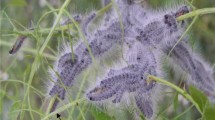Summary
The bud-galling sawfly, Euura mucronata, attacked longer shoot length classes on its host, Salix cinerea, more frequently than shorter shoots. Shoot length accounted for 76 to 93 percent of the variance in number of galls per 100 shoots in three habitats: forest, watermeadow, and lakeside. The reasons for this pattern were addressed with studies on shoot length in relation to: 1. Number of resources (buds) per shoot; 2. Success in establishment of larvae in galls; 3. Gall size and resources per gall; and 4. Survival of larvae after establishment as influenced by plant resistance and natural enemy attack. The most important factors proved to be success in establishment of larvae, with percent of variance accounted for ranging from 57 to 77 percent in three of four sites where relationships were significant, and survival after establishment of larvae, with variance accounted for ranging from 40 to 54 percent in the same three sites. The pattern of survival was dictated by plant resistance and not by natural enemies. These two additive factors resulted in a general relationship across all sites of increasing emergence of fully developed larvae per cohort as shoot length increased, accounting for 78 percent of the variance. These adaptive advantages to attacking longer shoots are sufficient to account for the pattern of increased probability of shoots being attacked as they increase in length.
Similar content being viewed by others
References
Berryman AA (1982) Population dynamics of bark beetles. In: Mitton JB, Sturgeon KB (eds) Bark beetles in North American conifers. Univ Texas Press, Austin, pp 264–314
Craig TP, Price PW, Itami JK (1986) Resource regulation by a stem-galling sawfly on the arroyo willow. Ecology 67:419–425
Dannell K, Huss-Dannell K (1985) Feeding by insects and hares on birches earlier affected by moose browsing. Oikos 44:75–81
Dannell K, Huss-Dannell K, Bergström R (1985) Interactions between browsing moose and two species of birch in Sweden. Ecology 66:1867–1878
Dixon AFG (1973) Biology of aphids. Arnold, London
Futuyma DJ, Wasserman SS (1981) Food plant specialization and feeding efficiency in the tent caterpillars, Malacosoma disstria and M. americanum. Ent Exp Appl 30:106–110
Futuyma DJ, Cort RP, van Noordwijk I (1984) Adaptation to host plants in the fall cankerworm (Alsophila pometaria) and its bearing on the evolution of host affiliation in phytophagous insects. Am Nat 123:287–296
Gilbert LE (1979) Development of theory in the analysis of insectplant interactions. In: Horn DJ, Stairs GR, Mitchell RD (eds) Analysis of ecological systems. Ohio State Univ Press, Columbus, pp 117–154
Moran NA (1983) Seasonal shifts in host usage in Uroleucon gravicorne (Homoptera:Aphididae) and implications for the evolution of host alternation in aphids. Ecol Entomol 8:371–382
Moran NA (1984) Reproductive performance of a specialist herbivore, Uroleucon nigrotibium (Homoptera), on its host and on a non-host. Oikos 42:171–175
Moran NA (1986) Benefits of host plant specificity in Uroleucon (Homoptera:Aphididae). Ecology 67:108–115
Price PW (1987a) Evolution and ecology of gall-inducing sawflies. In: Shorthouse JD, Rohfritsch O (eds) Biology of insect and mite induced galls. Praeger, New York (in press)
Price PW (1987b) The role of natural enemies in insect population dynamics. In: Barbosa P, Schultz JC (eds) Insect outbreaks. Academic, New York (in press)
Price PW (1988) Inversely density-dependent parasitism: The role of plant refuges for hosts. J Anim Ecol (in press)
Price PW, Clancy KM (1986a) Multiple effects of precipitation on Salix lasiolepis and populations of the stem-galling sawfly, Euura lasiolepis. Ecol Res 1:1–14
Price PW, Clancy KM (1986b) Interactions among three trophic levels: Gall size and parasitoid attack. Ecology 67:1593–1600
Price PW, Craig TP (1984) Life history, phenology, and survivorship of a stem-galling sawfly, Euura lasiolepis (Hymenoptera: Tenthredinidae), on the arroyo willow, Salix lasiolepis in northern Arizona. Ann Entomol Soc Am 77:712–719
Price PW, Roininen H, Tahvanainen J (1987) Plant age and attack by the bud galler, Euura mucronata. Oecologia (Berlin) 73:334–337
Pschorn-Walcher H (1982) Unterordnung Symphyta, Pflanzenwespen. In: Schwenke W (ed) Die Forstschädlinge Europas, Parey, Hamburg, pp 4–234
Scriber JM, Feeny P (1979) Growth of herbivorous caterpillars in relation to feeding specialization and to the growth form of their food plants. Ecology 60:829–850
Singer MC (1971) Evolution of food-plant preference in the butterfly Euphydryas editha. Evolution 25:383–389
Smiley J (1978) Plant chemistry and the evolution of host specificity: new evidence from Heliconius and Passiflora. Science 201:745–747
Whitham TG (1978) Habitat selection by Pemphigus aphids in response to resource limitation and competition. Ecology 59:1164–1176
Whitham TG (1980) The theory of habitat selection: Examined and extended using Pemphigus aphids. Am Nat 115:449–466
Zucker WV (1982) How aphids choose leaves: The roles of phenolics in host selection by a galling aphid. Ecology 63:972–981
Author information
Authors and Affiliations
Rights and permissions
About this article
Cite this article
Price, P.W., Roíninen, H. & Tahvanainen, J. Why does the bud-galling sawfly, Euura mucronata, attack long shoots?. Oecologia 74, 1–6 (1987). https://doi.org/10.1007/BF00377338
Received:
Issue Date:
DOI: https://doi.org/10.1007/BF00377338




